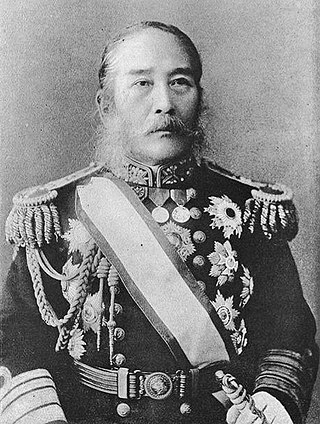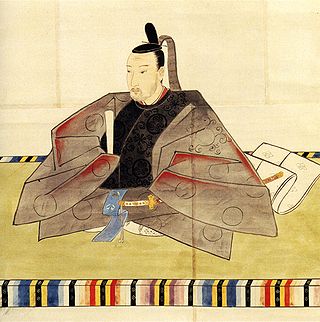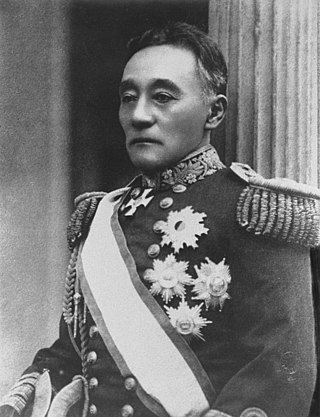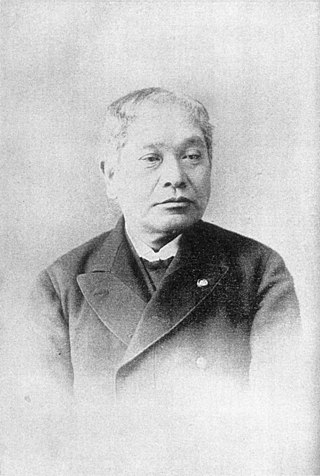Related Research Articles

The Tokugawa shogunate, also known as the Edo shogunate, was the military government of Japan during the Edo period from 1603 to 1868.

Ōkubo Toshimichi was a Japanese statesman and one of the Three Great Nobles regarded as the main founders of modern Japan.

ViscountEnomoto Takeaki was a Japanese samurai and admiral of the Tokugawa navy of Bakumatsu period Japan, who remained faithful to the Tokugawa shogunate and fought against the new Meiji government until the end of the Boshin War. He later served in the Meiji government as one of the founders of the Imperial Japanese Navy.

Count Katsu Yasuyoshi was a Japanese statesman, naval engineer and military commander during the late Tokugawa shogunate and early Meiji period.

Saigō Takamori was a Japanese samurai and nobleman. He was one of the most influential samurai in Japanese history and one of the three great nobles who led the Meiji Restoration. Living during the late Edo and early Meiji periods, he later led the Satsuma Rebellion against the Meiji government. Historian Ivan Morris described him as "the quintessential hero of modern Japanese history".

The Boshin War, sometimes known as the Japanese Revolution or Japanese Civil War, was a civil war in Japan fought from 1868 to 1869 between forces of the ruling Tokugawa shogunate and a coalition seeking to seize political power in the name of the Imperial Court.

The Satsuma Rebellion, also known as the Seinan War, was a revolt of disaffected samurai against the new imperial government of Japan, nine years into the Meiji era. Its name comes from the Satsuma Domain, which had been influential in the Restoration and became home to unemployed samurai after military reforms rendered their status obsolete. The rebellion lasted from 29 January until 24 September of 1877, when it was decisively crushed, and its leader, Saigō Takamori, was shot and mortally wounded.

Tokugawa Iesada was the 13th shōgun of the Tokugawa shogunate of Japan. He held office for five years from 1853 to 1858. He was physically weak and was therefore considered by later historians to have been unfit to be shōgun. His reign marks the beginning of the Bakumatsu period.

The Satsuma–Chōshū Alliance, or Satchō Alliance was a powerful military alliance between the southwestern feudal domains of Satsuma and Chōshū formed in 1866 to combine their efforts to restore Imperial rule and overthrow the Tokugawa shogunate of Japan.

The Battle of Shiroyama took place on 24 September 1877, in Kagoshima, Japan. It was the final battle of the Satsuma Rebellion, where the heavily outnumbered samurai under Saigō Takamori made their last stand against Imperial Japanese Army troops under the command of General Yamagata Aritomo and Admiral Kawamura Sumiyoshi. The battle culminated in the annihilation of Saigō and his army, marking the end of the Satsuma Rebellion. The Imperial Army's victory consolidated their power, and the Satsuma Rebellion was the last instance of internal mutiny seen in the Empire of Japan.

Shimazu Nariakira was a Japanese feudal lord (daimyō) of the Edo period, the 28th in the line of Shimazu clan lords of Satsuma Domain.

Count Kawamura Sumiyoshi, was an admiral in the Imperial Japanese Navy. Kawamura's wife Haru was the aunt of Saigō Takamori.

The Satsuma Domain, briefly known as the Kagoshima Domain, was a domain (han) of the Tokugawa shogunate of Japan during the Edo period from 1602 to 1871.

Saigō Jūdō was a Japanese politician and admiral in the Meiji period.

The Battle of Ueno was a battle of the Boshin War, which occurred on July 4, 1868, between the troops of the Shōgitai under Shibusawa Seiichirō and Amano Hachirō, and Imperial "Kangun" troops.

The Ōuetsu Reppan Dōmei was a Japanese military-political coalition established and disestablished over the course of several months in early to mid-1868 during the Boshin War. Its flag was either a white interwoven five-pointed star on a black field, or a black interwoven five-pointed star on a white field. It is also known as the Northern Alliance.

Count Ōki Takatō, was a Japanese statesman during the early Meiji period. He was Governor of Tokyo in 1868 and a member of the Japanese Privy Council in 1889.

The Seikanron was a major political debate in Japan during 1873 regarding a punitive expedition against Korea. The Seikanron split the Meiji government and the restoration coalition that had been established against the bakufu, but resulted in a decision not to send a military expedition to Korea.

The Meiji Restoration, referred to at the time as the Honorable Restoration, and also known as the Meiji Renovation, Revolution, Regeneration, Reform, or Renewal, was a political event that restored practical imperial rule to Japan in 1868 under Emperor Meiji. Although there were ruling emperors before the Meiji Restoration, the events restored practical abilities and consolidated the political system under the Emperor of Japan. The goals of the restored government were expressed by the new emperor in the Charter Oath.
The Shizoku was a social class in Japan composed of former samurai after the Meiji Restoration from 1869 to 1947. Shizoku was a distinct class between the kazoku and heimin (commoners) with no special class privileges, and the title was solely on the register. The Shizoku were abolished in the revised civil code in 1947 after the Japanese defeat in World War II.
References
- ↑ "Profile for Mark Ravina at UT Austin". liberalarts.utexas.edu. Retrieved 2022-05-13.
- ↑ Toby, Ronald. "Rescuing the Nation from History: the State of the State in Early Modern Japan." Monumenta Nipponica 56:2 (2001). p201.
- ↑ Mark Ravina | in Atlanta, Georgia at the Department of History, Emory University Archived June 9, 2010, at the Wayback Machine
- ↑ Columbia College (Columbia University). Office of Alumni Affairs and Development; Columbia College (Columbia University) (May 2004). Columbia College today. Columbia University Libraries. New York, N.Y. : Columbia College, Office of Alumni Affairs and Development.